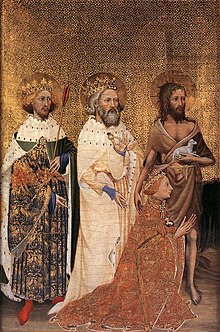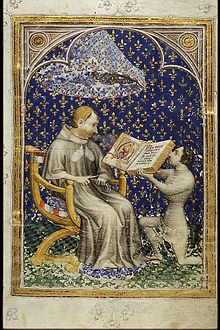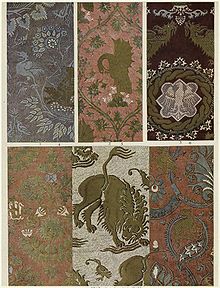Traveling within the World
Linking your favorite traveling artists across the globe

Fashion in fourteenth century Europe was marked by the beginning of a period of experimentation with different forms of clothing. Costume historian James Laver suggests that the mid-14th century marks the emergence of recognizable "fashion" in clothing,[1] in which Fernand Braudel concurs.[2] The draped garments and straight seams of previous centuries were replaced by curved seams and the beginnings of tailoring, which allowed clothing to more closely fit the human form. Also, the use of lacing and buttons allowed a snugger fit to clothing.[3]
General trends
In the course of the century the length of female hem-lines progressively reduced, and by the end of the century it was fashionable for men to omit the long loose over-garment of previous centuries (whether called gown, kirtle, or other names) altogether, putting the emphasis on a tailored top that fell a little below the waist—a silhouette that is still reflected in men's costume today.[4]
From this century onwards Western fashion changes at a pace quite unknown to other civilizations, whether ancient or contemporary.[5] In most other cultures only major political changes, such as the Muslim conquest of India, produced radical changes in clothing, and in China, Japan, and the Ottoman Empire fashion changed only slightly over periods of several centuries.[6]
The French court during the minority and illness of Charles VI, filled with ambitious princes with a taste for luxury, was a fountain of innovation in fashion.[7] Italian clothing was led by the Visconti court in Milan.
Fabrics and furs

Wool was the most important material for clothing, due to its numerous favorable qualities, such as the ability to take dye and its being a good insulator.[8] This century saw the beginnings of the Little Ice Age, and glazing was rare, even for the rich (most houses just had wooden shutters for the winter). Trade in textiles continued to grow throughout the century, and formed an important part of the economy for many areas from England to Italy. Clothes were very expensive, and employees, even high-ranking officials, were usually supplied with, typically, one outfit per year, as part of their remuneration.
Woodblock printing of cloth was known throughout the century, and was probably fairly common by the end; [9] this is hard to assess as artists tended to avoid trying to depict patterned cloth due to the difficulty of doing so. Embroidery in wool, and silk or gold thread for the rich, was used for decoration. Edward III established an embroidery workshop in the Tower of London, who presumably produced the robes he and his Queen wore in 1351 of red velvet "embroidered with clouds of silver and eagles of pearl and gold, under each alternate cloud an eagle of pearl, and under each of the other clouds a golden eagle, every eagle having in its beak a Garter with the motto hony soyt qui mal y pense" embroidered thereon." [10]
Although wool was used for the outer layers of clothing, linen, made from the flax plant, was generally used for clothing that was directly in contact with the skin, as it was not as coarse as wool and therefore much more pleasant.[8] Unlike wool, linen could also be laundered and bleached in the sun. Cotton, imported raw from Egypt and elsewhere, was used for padding and quilting, and cloths such as buckram and fustian.
Silk was the finest fabric of all. In Northern Europe, silk was an imported and very expensive luxury.[11] The well-off could afford woven brocades from Italy or even further afield. Fashionable Italian silks of this period featured repeating patterns of roundels and animals, deriving from Ottoman silk-weaving centres in Bursa, and ultimately from Yuan Dynasty China via the Silk Road.[12]
A fashion for mi-parti or parti-coloured garments made of two contrasting fabrics, one on each side, arose for men in mid-century,[13] and was especially popular at the English court. Sometimes just the hose would be different colours on each leg.
Checkered and plaid fabrics were occasionally seen; a parti-colored cotehardie depicted on the St. Vincent altarpiece in Catalonia is reddish-brown on one side and plaid on the other, and remains of plaid and checkered wool fabrics dating to the 14th century have also been discovered in London.[14]
Fur was mostly worn as an inside lining for warmth; inventories from Burgundian villages show that even there a fur-lined coat (rabbit, or the more expensive cat) was one of the commonest garments.[15] Vair, the fur of the squirrel, white on the belly and grey on the back, was particularly popular through most of the century and can be seen in many illuminated manuscript illustrations, where it is shown as a white and blue-grey softly striped or checkered pattern lining cloaks and other outer garments; the white belly fur with the merest edging of grey was called miniver.[16] A fashion in men's clothing for the dark furs sable and marten arose around 1380, and squirrel fur was thereafter relegated to formal ceremonial wear.[17] Ermine was worn by royalty, with tufts of black fur worked through the white for decorative effect, as in the Wilton Diptych above.
Men's clothing
Shirt, doublet and hose
The innermost layer of clothing were the braies or breeches, a loose undergarment, usually made of linen, which was held up by a belt.[18] Next came the shirt, which was generally also made of linen, and which was considered an undergarment, like the breeches.[18]

Hose or chausses made out of wool were used to cover the legs, and were generally brightly colored, and often had leather soles, so that they did not have to be worn with shoes.[18] The shorter clothes of the second half of the century required these to be a single garment like modern tights, whereas otherwise they were two separate pieces covering the full length of each leg. Hose were generally tied to the breech belt, or to the breeches themselves, or to a doublet.[18]
A doublet was a buttoned jacket that was generally of hip length. Similar garments were called cotehardie, pourpoint, jaqueta or jubón.[19] These garments were worn over the shirt and the hose.
Gown and coteheardie
A gown, tunic or kirtle was usually worn over the shirt or doublet.[18] As with other outer garments, it was generally made of wool.[18] Over this, a man might also wear an over-kirtle, cloak, or a hood.[20] Servants and working men wore their kirtles at various lengths, including as low as the knee or calf. However the trend during the century was for hem-lengths to shorten for all classes.
However, in the second half of the century, courtiers are often shown, if they have the figure for it, wearing nothing over their closely tailored cotehardie. A French chronicle records: "Around that year (1350), men, in particular noblemen and their squires, took to wearing tunics so short and tight that they revealed what modesty bids us hide. This was a most astonishing thing for the people"[21] This fashion may well have derived from military clothing, where long loose gowns were naturally not worn in action. At this period, the most dignified figures, like King Charles in the illustration, continue to wear long gowns—although as the Royal Chamberlain, de Vaudetar was himself a person of very high rank. This abandonment of the gown to emphasise a tight top over the torso, with breeches or trousers below, was to become the distinctive feature of European men's fashion for centuries to come.

The funeral effigy and "achievements" of Edward, the Black Prince in Canterbury Cathedral, who died in 1376, show the military version of the same outline. Over armour he is shown wearing a short fitted arming-coat or jupon or gipon, the original of which was hung above and still survives. This has the quartered arms of England and France, with a rather similar effect to a parti-coloured jacket. The "charges" (figures) of the arms are embroidered in gold on linen pieces, appliquéd onto coloured silk velvet fields. It is vertically quilted, with wool stuffing and a silk satin lining. This type of coat, originally worn out of sight under armour, was in fashion as an outer garment from about 1360 until early the next century. Only this and a child's version (Chartres Cathedral) survive.[22] As an indication of the rapid spread of fashion between the courts of Europe, a manuscript chronicle illuminated in Hungary by 1360 shows very similar styles to Edward's English version.
Edward's son, King Richard II of England, led a court that, like many in Europe late in the century, was extremely refined and fashion-conscious. He himself is credited with having invented the handkerchief; "little pieces [of cloth] for the lord King to wipe and clean his nose," appear in the Household Rolls (accounts), which is the first documentation of their use. He distributed jewelled livery badges with his personal emblem of the white hart (deer) to his friends, like the one he himself wears in the Wilton Diptych (above). In the miniature (left) of Chaucer reading to his court both men and women wear very high collars and quantities of jewellery. The King (standing to the left of Chaucer; his face has been defaced) wears a patterned gold-coloured costume with matching hat. Most of the men wear chaperon hats, and the women have their hair elaborately dressed. Male courtiers enjoyed wearing fancy-dress for festivities; the disastrous Bal des Ardents in 1393 in Paris is the most famous example. Men as well as women wore decorated and jewelled clothes; for the entry of the Queen of France into Paris in 1389, the Duke of Burgundy wore a velevet doublet embroidered with forty sheep and forty swans, each with a pearl bell round its neck.[23]
A new garment, the Houppelande, appeared around 1380 and was to remain fashionable well into the next century.[24] It was essentially a gown with fullness falling from the shoulders, very full trailing sleeves, and the high collar favored at the English court. The extravagance of the sleeves was criticised by moralists.
Headgear and accessories
During this century, the chaperon made a transformation from being a utilitarian hood with a small cape to becoming a complicated and fashionable hat worn by the wealthy in town settings. This came when they began to be worn with the opening for the face placed instead on the top of the head.
Belts were worn below waist at all times, and very low on the hips with the tightly fitted fashions of the latter half of the century. Belt pouches or purses were used, and long daggers, usually hanging diagonally to the front.
In armour, the century saw increases in the amount of plate armour worn, and by the end of the century the full suit had been developed, although mixtures of chain mail and plate remained more common. The visored bascinet helmet was a new development in this century. Ordinary soldiers were lucky to have a mail hauberk, and perhaps some cuir-boulli ("boiled leather") knee or shin pieces.[25]
Style gallery
- Braies are worn rolled over a belt at the waist. Catalonia.
- Shirt is made of rectangles with gussets at shoulder, underarm, and hem.
- Serving man wears a knee-length tunic or kirtle with long, tight sleeves over hose. Wears a belt with a waist-pouch or purse. His shoes are pointed. From the Luttrell Psalter, England, c. 1325–35.
- Bridegroom wears a red cotehardie, hose, and hood, Italy, 1350s.
- Man in a particolored cotehardie of reddish brown and plaid fabric, 2nd half of the 14th century, Catalonia. The cotehardie fits snugly and is buttoned up the front. A narrow belt is worn around the hips.
- Huntsman wears side-lacing boots, late 14th century.
- Man walking in a brisk wind wears a chaperon that has been caught by a gust. He wears a belt pouch and carries a walking stick, late 14th century.
- Older man (chiding an indiscreet young woman, see image below) wears a long, loose houppelande. The fashionable young men wear short gowns, one with dagged edges. The man on the right wears shoes with long pointed toes, late 14th century.
Women's clothing
Tags:
Replies to This Discussion
Events
-
2014 is the Chinese Year of the Horse
February 17, 2026 at 12am to February 5, 2027 at 12am – where & how you choose
Birthdays
Birthdays Tomorrow
Important (read & understand)
Skype: Travelingraggyman
Email and Instant Messenger:
TravelerinBDFSM @ aol/aim; hotmail; identi.ca; live & yahoo
OR
Travelingraggyman @ gmail and icq ***

1AWARD UPDATES & INFORMATION
10,000 votes - Platinum Award
5,000 votes - Gold Award
2,500 votes - Silver Award
1,000 votes - Bronze Award
300 votes - Pewter Award
100 votes - Copper Award
Member of the Associated Posting System {APS}
This allows members on various sites to share information between sites and by providing a by line with the original source it credits the author with the creation.
Legal Disclaimer
***************We here at Traveling within the World are not responsible for anything posted by individual members. While the actions of one member do not reflect the intentions of the entire social network or the Network Creator, we do ask that you use good judgment when posting. If something is considered to be inappropriate it will be removed
Site Meter
This site is strictly an artist operational fan publication, no copyright infringement intended
Patchwork Merchant Mercenaries had its humble beginnings as an idea of a few artisans and craftsmen who enjoy performing with live steel fighting. As well as a patchwork quilt tent canvas. Most had prior military experience hence the name.
Patchwork Merchant Mercenaries.
Vendertainers that brought many things to a show and are know for helping out where ever they can.
As well as being a place where the older hand made items could be found made by them and enjoyed by all.
We expanded over the years to become well known at what we do. Now we represent over 100 artisans and craftsman that are well known in their venues and some just starting out. Some of their works have been premiered in TV, stage and movies on a regular basis.
Specializing in Medieval, Goth , Stage Film, BDFSM and Practitioner.
Patchwork Merchant Mercenaries a Dept of, Ask For IT was started by artists and former military veterans, and sword fighters, representing over 100 artisans, one who made his living traveling from fair to festival vending medieval wares. The majority of his customers are re-enactors, SCAdians and the like, looking to build their kit with period clothing, feast gear, adornments, etc.
Likewise, it is typical for these history-lovers to peruse the tent (aka mobile store front) and, upon finding something that pleases the eye, ask "Is this period?"
A deceitful query!! This is not a yes or no question. One must have a damn good understanding of European history (at least) from the fall of Rome to the mid-1600's to properly answer. Taking into account, also, the culture in which the querent is dressed is vitally important. You see, though it may be well within medieval period, it would be strange to see a Viking wearing a Caftan...or is it?
After a festival's time of answering weighty questions such as these, I'd sleep like a log! Only a mad man could possibly remember the place and time for each piece of kitchen ware, weaponry, cloth, and chain within a span of 1,000 years!! Surely there must be an easier way, a place where he could post all this knowledge...
Traveling Within The World is meant to be such a place. A place for all of these artists to keep in touch and directly interact with their fellow geeks and re-enactment hobbyists, their clientele.
© 2024 Created by Rev. Allen M. Drago ~ Traveler.
Powered by
![]()













